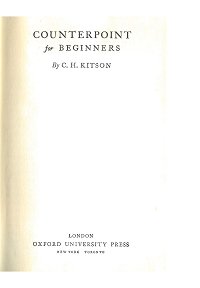|
Kitson - Counterpoint for beginners |
Kitson - Counterpoint for beginners
Kitson - Counterpoint for beginners. You can download the PDF sheet music Kitson - Counterpoint for beginners on this page. Simple Counterpoint is studied in two and three parts simultaneously. Good two-part writing is really the result of three-part study. It is only attained when the harmonic implications of two-part work are realized. When the semibreve is the unit, the barring is so arranged as to mark the proper accentuation. (First and Second Species, uncombined.) In Chapter VI an attempt is made to arrive at the technique of Combined Florid Counterpoint, without going through the somewhat tedious procedure of working long exercises in the various combinations of species. The difficulties of maintaining definite patterns for ten or twelve bars are not involved in combined florid work. Thus separate Exercises of a bar or two at most are given in combinations that will be required in florid work. The technique covers every possible combination, presented in as systematic a way as author can devise.
To download PDF, click the "Download PDF" button below the appropriate sheet music image.
To view the first page of Kitson - Counterpoint for beginners click the music sheet image. |
| PDF format sheet music |
|
|
|
Instrument part: 112 pages. 14448 K
|
|
 |
|
|
|
| Download PDF (14.99
€) |
|
|
|
There can be no argument as to the source of the technique of Strict Counterpoint ; but there can be two views as to the reason for studying that technique. One view is that the goal is composition in the style of the sixteenth century. It may be mentioned in passing that the average student will never reach that goal, and does not desire to do so. A second view is that a study of this technique serves as the best preliminary training for modern contrapuntal style. Some one will say, why not make the technique the same as that of harmony, that is to say, free. There is much to say for that argument. But experience shows that discipline is necessary in music as in everything else, and secondly that when the beginner is grappling with the problems of contrapuntal style, he must not at the same time be worried with harmonic problems. In other words, the simpler the resource, the better the contrapuntal results. Good counterpoint is the result of harmonic mastery. Therefore for the beginner, the simpler the harmonic resource, the better will be the counterpoint.
But again, some one will say, the technique of Strict Counterpoint was developed before any harmonic period existed. Surely then, the right thing is to begin with Strict Counterpoint. Experience shows that if that method be adopted, progress is amazingly slow. And the reason is not far to seek. By the time of Palestrina, minds were really awakening to the harmonic aspect of music, and composers wrote what was harmonically satisfactory from a really remarkable feeling for the harmonic side of technique. The harmonic aspect of music was about to be brought to the birth. The average student has not much lristinct, and the reasons for nearly all his errors in counterpoint are far more easily explained from a harmonic point of view. Before counterpoint is studied, the pupil should have taken a course of harmony up to diatonic sevenths and suspensions, including the use of unessential notes and elementary modulation. This course is presumed in this treatise. |
|